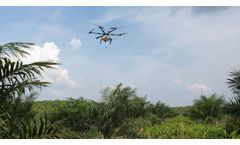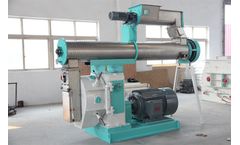Refine by
Sugarcane Articles & Analysis
35 news found
Waste Utilization and Sustainability Agricultural Residue Conversion 1.Crop Residue: Charcoal making machines efficiently convert agricultural residues such as corn stalks and sugarcane bagasse into valuable charcoal. This not only reduces waste but also generates an additional income stream for farmers. 2.Coconut Shells, Rice Husks, and More: Besides crop residues, machines are ...
” Peled said that Taranis currently focuses its efforts on assisting sugarcane growing in Brazil and in the midwestern US, where they specialize in open field core crops: corn, soybeans and cotton. ...
ByTaranis
Avirtech operates across a wide range of crops, from large-scale plantations such as palm oil, sugarcane to smallholders such as rice, corn, coffee, cocoa to promote sustainable agriculture for a better future. ...
The entire process of refining sugar involves cutting up sugarcane into small pieces then crushing it to extract the juice. After the process is over, the leftover pulp in the sugarcane, which is known as bagasse, is often discarded. Imagine just how much less organic waste would originate from the sugar making process in case the sugarcane pulp ...
Amyris is proud to own and operate a family of consumer brands - all built around its No Compromise® promise of clean ingredients: Biossance® clean beauty skincare, Pipette® clean baby skincare, and Purecane™, a zero-calorie sweetener naturally derived from sugarcane. For more information, please visit www.amyris.com. Forward-Looking Statements This release ...
Although we use sugar on a daily basis, most people do not know how the processes of extracting liquid juice from sugarcane. To extract juice, the sugar cane is literally crushed to remove the juice. As a result, a fibrous byproduct called bagasse is left behind. From every ten tonnes of sugarcane, 3 tonnes of bagasse is produced. It is usually changed into ...
His research work spans over 20 years and the contribution he has made to winegrape and sugarcane production is best described as ‘pioneering’. He has published many articles in peer-reviewed journals and in popular industry magazines, including SPAA’s own quarterly magazine Precision Ag News. ...
A Brazilian scientist who developed a method that reduces greenhouse gas emissions from sugarcane cultivation has been awarded a prize that each year recognises a researcher whose work has excelled in the area of fertiliser use. ...
Surprisingly, the modified sugarcane plants also produced more sugar, which can be used for producing ethanol. ...
Brazil has a huge agricultural market and is one of the world’s largest exporters of coffee, soybeans, beef and sugarcane. It plays a major role in keeping the world properly fed. Current Brazilian agricultural challenges and opportunities will be reviewed through interactive discussions. ...
Just as wood fires from felled timber make no difference to the atmosphere’s carbon dioxide levels – because the same forest that shelters the fallen tree will absorb it again – so biofuels converted from surplus maize or sugarcane should, in theory, make no difference to global warming. So the idea of what the Harvard team call “bionic leaf 2.0” is ...
The research project is called Plants Engineered To Replace Oil in Sugarcane and Sweet Sorghum (PETROSS), and this is the third round of funding that it will receive from ARPA-E. PETROSS is engineering sugarcane and sorghum to produce 20 percent oil, compared to the 0.05 percent oil that is naturally provided. ...
Biofuels are another driver of cropland expansion in some Latin American countries. For example, sugarcane from Brazil is used for biofuel production. Credit: Jordan Graesser (click to enlarge) BACKGROUND The study, “Cropland/pastureland dynamics and the slowdown of deforestation in Latin America,” is published inEnvironmental Research Letters. ...
C4 crops including maize, sorghum, switchgrass and sugarcane are able to withstand drought, heat, nitrogen and carbon dioxide limitations better than C3 crops, such as rice, wheat, barley and oats, due to their ability to efficiently make use of carbon dioxide and water that make carbohydrates we eat and cell wall polysaccharides; the sugars that are important to producing ...
In all, they exceed the value of the state's next several largest crops - including sugarcane and macadamia nuts. Developing a new seed variety takes about 10 to 12 growth cycles, said Phillipson. ...
The National Biosafety Committee (CNBS) in Brazil has ratified a decision authorising sales of corn containing Syngenta’s Bt11 trait for Fall Armyworm and Sugarcane Borer control. Davor Pisk, Chief Operating Officer of Syngenta Seeds, said: “We are very pleased to have obtained this approval which will enable us to play a leading role in the introduction of new corn ...
BySyngenta
However, unlike traditional hard hats, the HDPE in the MSA V-Gard GRN model is sourced entirely from sugarcane. "By developing a hard hat sourced from sugar, we have reduced the overall carbon footprint that's associated with the entire life-cycle of this particular product, from start to finish," said Eric Beck, MSA's Global Director of Strategic Marketing. ...
Sweet sorghum is a hardy crop that can extend the ethanol production season by up to 60 days in Brazil. It can be grown on fallow sugarcane land and processed using the same equipment. Since it grows in just 90 to 120 days, it requires less water and other inputs than sugarcane. ...
ByCeres
The study looked at more than 1,140 publications that have projected the impact of climate change on eight key food and commodity crops (rice, wheat, maize, sorghum, millet, cassava, yam, and sugarcane) that together account for more than 80 per cent of total crop production in the two regions, and then analysed 52 of those studies in depth. ...
In addition, the impact on public health and the environment will be measured by tracking the use of insecticides in rice and sugarcane crops. The Mexican rice borer was first discovered in Louisiana in 2008 and is a devastating pest of sugarcane and a serious pest of rice. ...
















